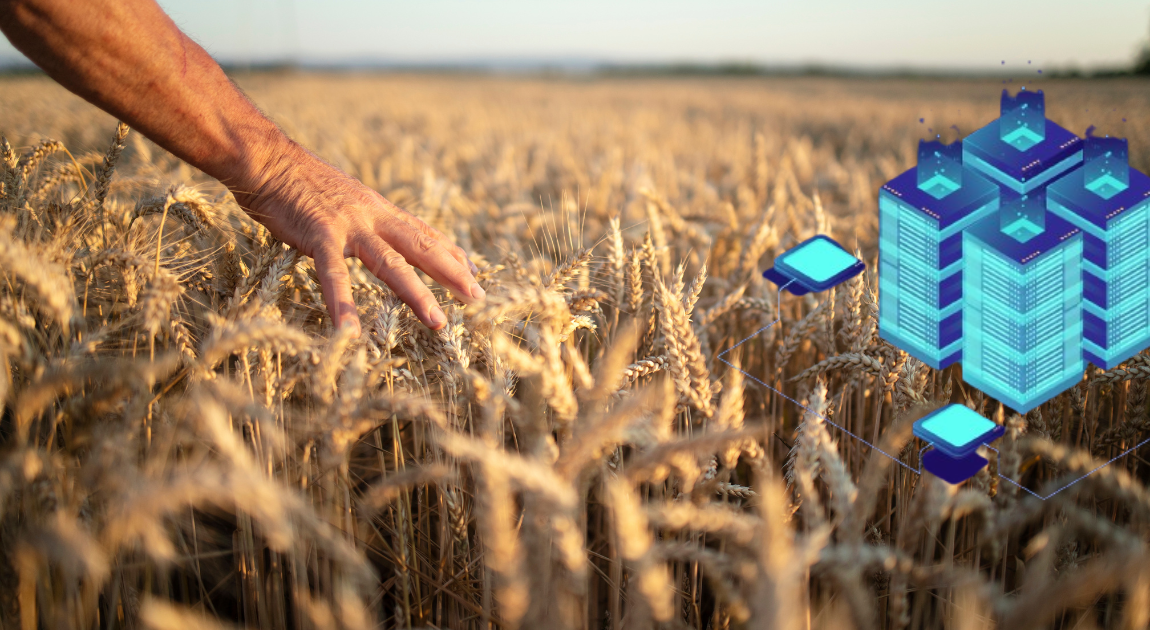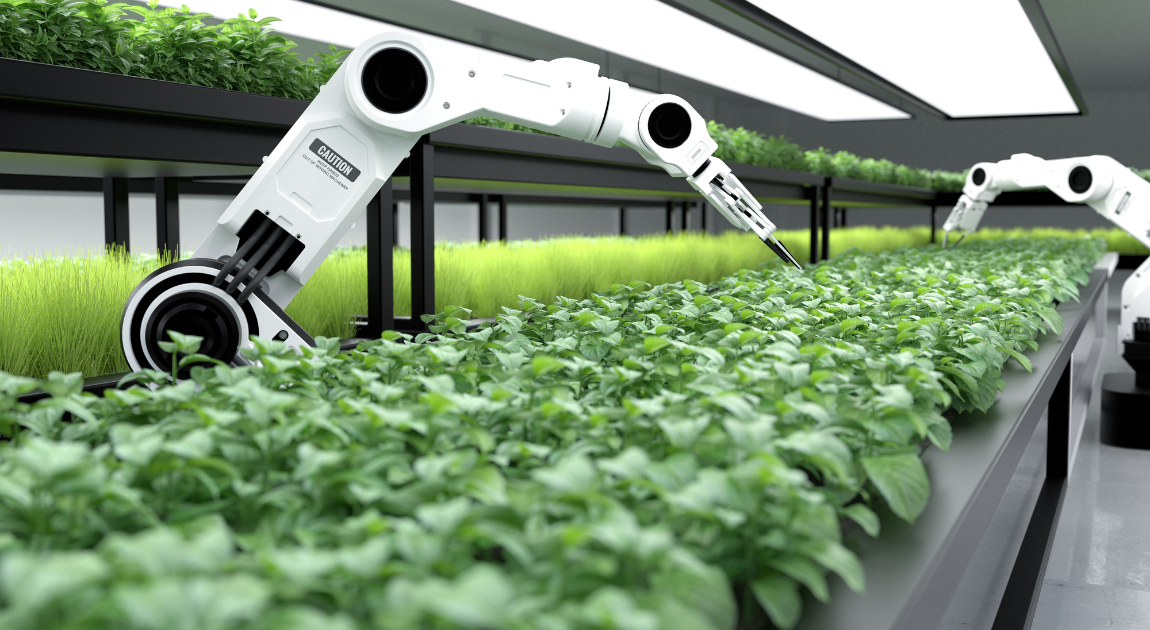Blockchain in agriculture already has multiple success cases for both farm development, businesses along the food supply chain, and consumer safety. Interestingly, its benefits are not just felt at the general industry level, but extend to pure profitability, on the one hand, and sustainability, on the other. However, there are several important considerations to make that work. In this article, we look at the current use of blockchain in agriculture, some famous success stories, and analyze why this works.
The role of blockchain in agriculture and food industry
Blockchain is a decentralized digital ledger where each transaction (or block) is cryptographically linked to the previous one, making the data within tamper-resistant. This makes blockchain and smart contracts based on blockchain valuable for the convoluted modern agricultural supply chains.
As of today, agriculture is infinitely more complicated than it used to be, with multiple players (from farmers to retailers and beyond), larger geographies for perishable products, spanning various safety risks and compliance requirements. The traceability that blockchain provides, from seed to shelf (and with things like fertilizers, from factory to seed), is a large factor in achieving trust and sustainability credentials, not to mention food security.
Add to that the reduction in transaction costs, with paid middle men-hours out of the picture, and it’s clear why the blockchain for agriculture sector reached USD 302.8 million in 2023, with a projected CAGR over 36% from 2024 to 2032.
Key technologies: smart contracts, IoT, and more
There are two main technological “tangents” where blockchain is applied to agricultural supply chain management, namely smart contracts and IoT-supported workflows.
- Smart contracts are essentially tamper-proof if-then scenarios that are used to automate payments once this or that condition is met. For example, a smart contract can automatically transfer funds to a farmer upon delivery and quality check – saving costs on processing the transaction and building trust, potentially helping establish fair trade principles.
- Meanwhile, IoT devices that are used to track data like temperature, humidity, etc. can be configured to hash those data into blockchain records automatically. In other words, what used to take an entire mobile app and trained personnel just several years ago, can now be automated. There have been success cases, too, like the pilot project with a Tunisian olive oil producer using dual blockchain (private Quorum and public Ethereum) plus IoT sensors to monitor the product across the food supply chain.
Another recent case study involves a sensor-based agricultural monitoring system that combines IoT, AI analytics, and blockchain, for an Indonesian agribusiness. The reported outcomes are impressive, with up to 22% overall productivity increase and 18% lower operational costs.
Blockchain for food safety and quality control
In 1854, when John Snow (not the one who “knew nothing”, the physician) traced a cholera outbreak in Soho, London to one water pump, this seemed like magic. However, traceability shortcomings persisted for a long time, still present, e.g. during the 2018 E.coli outbreak – something that blockchain is poised to change.
Food safety and quality assurance are, perhaps, the most readily demonstrable use case for blockchain in agriculture. A ledger model with timestamps is by itself already a powerful tool for quality tracking, and when other data is hashed alongside, it becomes a game-changer.
Many people have seen memes about rapidly spoiling bananas, but, e.g. mangoes are not much better in that respect. Walmart’s PoC project with IBM Food Trust addressed traceability issues for sliced mangoes, making the entire process faster: from 6 days and 18 hours with manual tracing to a 2.2 second blockchain-powered check. The platform is now said to be used for leafy greens and pork supply chains, as well.
Is blockchain a factor for agricultural sustainability?
Naturally, the first thing that comes to mind in conjunction with blockchain is traceability and its derivatives – safety, fraud prevention, fair trade, audit trails, etc. Curiously, however, the very same factor of immutable records makes blockchain systems valuable for sustainability in agriculture. Carbon footprint tracking, ethical sourcing and more, all that can (and currently is) managed through blockchain applications to bridge the gap between what the regulations demand, what consumers pay for, and what the supply chain is able to furnish.
Firstly, there already are platforms like AgriDigital and CIBO Impact, that use blockchain to record and verify carbon sequestration data from regenerative farming. Producers then trade the generated carbon credits.
IBM has entered the game, too, with IBM Blockchain Transparent Supply, which has shown itself in coffee supply chains, tracking sustainability on farm level to meet ESG metrics and certifications.
Other examples include Provenance in the UK (a blockchain system that food brands use to share data with consumers), Fishcoin for aquaculture, and more.
In short, blockchain’s immutable ledger is proving to be more than a compliance tool – it’s a mechanism for scaling sustainable agriculture, enabling precise environmental impact tracking, waste reduction, and ethical sourcing verification. In this way, sustainability evolves from marketing “fluff” to tangibly proven records.
The business benefits of blockchain in agriculture
What’s interesting about blockchain for agriculture is that it doesn’t just affect the entire industry positively, but brings tangible benefits business-wise to the company that implements it. Here are some of the most notable effects:
- Access to premium markets. The printed word “sustainable” is one thing, verified sustainability, quite another when it comes to positioning and export markets. For example, the Farmer Connect initiative enabled smallholder coffee farmers to secure up to 20% higher prices by meeting specialty coffee certification standards.
- Less waste and loss. Real-time tracking is generally good for avoiding inventory shrinkage and spoilage. In certain value chains, blockchain applications can help cut food waste up to 30%.
- Streamlined compliance. Smart contracts automate reporting, certification renewals, and audit trails, which means, for complex export chains, a 20-40% of administrative overhead reduction.
- Easier, faster collaboration with fewer disputes. By virtue of a single shared ledger, there’s less effort spent on reconciliations (and less situations that demand them).
- Greater resilience against fraud and counterfeit goods, as well as supply disruptions.
Implementing blockchain-based solutions for agri-food
The name of the game with blockchain applications is to have them implemented correctly, so that they don’t operate alongside the workflows like a parallel line, but are well-integrated. And that requires some tailoring to the unique realities of the particular food supply chains your company works with. Here’s a general roadmap:
- Assess the actual needs and goals. What are the pain points you want solved? Traceability gaps? Slow payments? Certification management? From there, you’ll automatically get the perfect list of stakeholders to participate (directly or indirectly) and systems to integrate, like ERP or others.
- Decide between off-the-shelf and custom solutions. On the one hand, going with something like IBM Food Trust or AgriDigital means you deploy the system faster, and that’s the perfect option when your workflows are close to the generic ideal. When you’re dealing with more convoluted supply chains or niche regulations, or unique proprietary software to integrate, custom solutions are worth every bit.
- Integration with IoT and data sources. Examples include cold-chain monitoring like temperature sensors, GPS collars on livestock, and many more; the question is, what data sources are crucial here and now, and which only need a potential for integration?
- Compliance and security. Regulatory standards that blockchain is supposed to help meet vary from place to place (EU Green Deal, USDA traceability mandates, etc.); plus, cybersecurity is important since the data entering the blockchain will likely be quite commercially sensitive.
- Stakeholder onboarding. Besides blockchain development itself, there’s usually a fair amount of interface to support actual use, like dashboards, mobile-first interfaces and so on – and then workshops to get the procedures going correctly.
The future of agricultural blockchain use
Seeing as how there are already hundreds of use cases of blockchain in agriculture and food sectors, we’re definitely past the buzzword stage. However, the long-term role of blockchain systems in the industry is still taking shape.
The good thing is everyone now realizes blockchain is not a magic wand per se – it’s as good as the data within it. This means that adoption rates tend to vary wildly, because many players in the agriculture sector still operate with limited digital tools, and in some cases, the supply chain is a bit like a railway – some portions are impeccable, while some consist of 19-century tracks and barnyards. Things are getting better, though, since the push for traceability is already pushing companies to invest in digitalization where it hasn’t been seen before.
In the next 5–10 years, we’re likely to see blockchain become invisible—not marketed as a standalone product, but embedded into farm management platforms, logistics software, and ERP systems. Farmers and distributors may not even think of it as “using blockchain”—just as “the way the system works.”
The key for businesses will be to cut through the hype and invest where blockchain creates measurable value—especially in areas like cold-chain monitoring, export compliance, and high-trust B2B relationships. Companies that align blockchain adoption with real operational needs, rather than trend-chasing, will be the ones to reap both financial and reputational rewards.
At Lionwood.software, we design custom blockchain solutions that integrate seamlessly with your logistics, inventory, and quality control workflows—so you get real, measurable benefits. You can contact our experts to assess how to best future-proof your agricultural operations.
FAQ
How does blockchain improve food traceability?
Blockchain creates an immutable record of every step in the supply chain—from farm to retailer—making it possible to trace products in seconds rather than days. For example, Walmart’s blockchain pilot reduced mango traceability time from nearly 7 days to just 2.2 seconds.
Is blockchain in agriculture expensive to implement?
Costs vary depending on whether you choose an off-the-shelf platform or a custom-built solution. Off-the-shelf systems like IBM Food Trust may be more affordable for standard workflows, while custom solutions pay off in complex or highly regulated supply chains by integrating seamlessly with existing ERP, IoT, and logistics systems.
Can blockchain work without IoT devices?
Yes—but IoT devices like temperature or humidity sensors significantly enhance blockchain’s value by automatically feeding verified, real-time data into the ledger. This ensures higher data accuracy and better operational insights.
What kinds of agricultural businesses benefit most from blockchain?
Producers and distributors of perishable, high-value, or regulated goods—such as fresh produce, meat, dairy, seafood, coffee, and specialty crops—see the greatest benefits. Export-focused businesses and those aiming for sustainability certifications also stand to gain.
How does blockchain support sustainability in agriculture?
Blockchain records can verify carbon credits, document ethical sourcing, and monitor environmental impact. This allows companies to meet ESG goals, comply with regulations, and appeal to conscious consumers with transparent proof rather than marketing claims.














